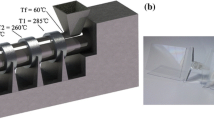Abstract
In this article, we described a simple and rapid method for fabrication of droplet microfluidic devices on polystyrene substrate using a CO2 laser system. The effects of the laser power and the cutting speed on the depth, width and aspect ratio of the microchannels fabricated on polystyrene were investigated. The polystyrene microfluidic channels were encapsulated using a hot press bonding technique. The experimental results showed that both discrete droplets and laminar flows could be obtained in the device.











Similar content being viewed by others
References
Becker H, Gartner C (2000) Polymer microfabrication methods for microfluidic analytical applications. Electrophoresis 21:12–26
Chen SC, Cahill DG, Grigoropoulos CP (2000) Melting and surface deformation in pulsed laser surface micromodification of Ni-P Disks. J Heat Transfer 122:107–112
Chen CS, Breslauer DN, Luna J, Grimes A, Chin W, Lee L, Khine M (2008) Shrinky-Dink microfluidics: 3D polystyrene chips. Lab Chip 8:622–624
Darain F, Gan KL, Tjin SC (2009) Antibody immobilization on to polystyrene substrate—on-chip immunoassay for horse IgG based on fluorescence. Biomed Microdevices 11:653–661
Dolnik V, Liu SR, Jovanovich S (2000) Capillary electrophoresis on microchip. Electrophoresis 21:41–54
Duffy DC, McDonald JC, Schueller OJA, Whitesides GM (1998) Rapid Prototyping of Microfluidic Systems in Poly(dimethylsiloxane). Anal Chem 70:4974–4984
Fair RB (2007) Digital microfluidics: is a true lab-on-a-chip possible? Microfluid Nanofluid 3:245–281
Gerlach A, Knebel G, Guber AE, Heckele M, Herrmann D, Muslia A, Sshaller T (2002) Microfabrication of single-use plastic microfluidic devices for high-throughput screening and DNA analysis. Microsyst Technol 7:265–268
Hoek I, Tho F, Arnold WM (2010) Sodium hydroxide treatment of PDMS based microfluidic devices. Lab Chip 10:2283–2285
Huang SM, Sun Z, Luk’yanchuk BS, Hong MH, Shi LP (2005) Nanobump arrays fabricated by laser irradiation of polystyrene particle layers on silicon. Appl Phys Lett 86:161911
Huang YG, Liu SB, Yang W, Yu CX (2010) Surface roughness analysis and improvement of PMMA-based microfluidic chip chambers by CO2 laser cutting. Appl Surf Sci 256:1675–1678
Huft J, Da Costa DJ, Walker D, Hansen CL (2010) Three-dimensional large-scale microfluidic integration by laser ablation of interlayer connections. Lab Chip 10:2358–2365
Jakeway SC, Mello AJ, Russell EL (2000) Miniaturized total analysis systems for biological analysis. Fresenius J Anal Chem 366:525–539
Jankowski P, Ogonczyk D, Kosinski A, Lisowski W, Garstecki P (2011) Hydrophobic modification of polycarbonate for reproducible and stable formation of biocompatible microparticles. Lab Chip 11:748–752
Kaur J, Boro RC, Wangoo N, Singh KR, Suri CR (2008) Direct hapten coated immunoassay format for the detection of atrazine and 2, 4-dichlorophenoxyacetic acid herbicides. Anal Chim Acta 607:92–99
Klank H, Kutter JP, Geschke O (2002) CO2-laser micromachining and back-end processing for rapid production of PMMA-based microfluidic systems. Lab Chip 2:242–246
Kodzius R, Xiao K, Wu J, Yi X, Gong X, Foulds I, Wen W (2011) Inhibitory effect of common microfluidic materials on PCR outcome. Sens Actuators B Chem. doi:10.1016/j.snb.2011.10.044
Li HW, Fan YQ, Foulds I (2012) Rapid and low cost fabrication of polystyrene-based molds for PDMS microfluidic devices using a CO2 laser. Adv Mater Res 403–408:4344–4348
Lim CT, Low HY, Ng JKK, Liu WT, Zhang Y (2009) Fabrication of three-dimensional hemispherical structures using photolithography. Microfluid Nanofluid 7:721–726
Link DR, Grasland-Mongrain E, Duri A, Sarrazin F, Cheng Z, Cristobal G, Marquez M, Weitz DA (2006) Electric control of droplets in microfluidic devices. Angew Chem Int Ed 118:2618–2622
Liu HB, Gong HQ (2009) Templateless prototyping of polydimethylsiloxane microfluidic structures using a pulsed CO2 laser. J Micromech Microeng 19:037002
Martynova L, Locascio LE, Gaitan M, Kramer GW, Christensen RG, MacCrehan WA (1997) Fabrication of plastic microfluid channels by imprinting methods. Anal Chem 69:4783–4789
Nayak NC, Lam Y, Yue C, Sinha TA (2008) CO2-laser micromachining of PMMA: the effect of polymer molecular weight. J Micromech Microeng 18:095020
Ogonczyk D, Wegrzyn J, Jankowski P, Dabrowski B, Garstecki P (2010) Bonding of microfluidic devices fabricated in polycarbonate. Lab Chip 10:1324–1327
Pla-Roca M, Juncker D (2011) PDMS microfluidic capillary systems for patterning proteins on surfaces and performing miniaturized immunoassays. Methods in mol biol (Clifton, NJ) 671:177–194
Qi H, Chen T, Yao LY, Zuo TC (2009) Micromachining of microchannel on the polycarbonate substrate with CO2 laser direct-writing ablation. Opt Laser Eng 47:594–598
Reedy CR, Price CW, Sniegowski J, Ferrance JP, Begley M, Landers JP (2011) Solid phase extraction of DNA from biological samples in a post-based, high surface area poly(methyl methacrylate) (PMMA) microdevice. Lab Chip 11:1603–1611
Rotting O, Ropke W, Becker H, Gartner C (2002) Polymer microfabrication technologies. Microsyst Technol 8:32–36
Snakenborg D, Klank H, Kutter JP (2004) Microstructure fabrication with a CO2 laser system. J Micromech Microeng 14:182–189
Tolstopyatov EM (2005) Ablation of polytetrafluoroet-hylene using a continuous CO2 laser beam. J Phys D Appl Phys 38:1993–1999
Urech L, Lippert T (2010) Photoablation of polymer materials. Photochemistry and Photophysics of Polymer Materials. Wiley, New York, pp 541–568
Wu SH (1970) Surface and Interfacial Tensions of Polymer Melts II. Poly(methyl methacrylate), Poly(n-butyl methacrylate) and Polystyrene. J Phys Chem 74:632–638
Yao X, Chen Z, Chen G (2009) Fabrication of PMMA microfluidic chips using disposable agar hydrogel templates. Electrophoresis 30:4225–4229
Yi X, Kodzius R, Gong X, Xiao K, Wen W (2010) A simple method of fabricating mask-free microfluidic devices for biological analysis. Biomicrofluidics 4(3). doi:10.1063/1.3487796
Young EWK, Berthier E, Guckenberger DJ, Sackmann E, Lamers C, Meyvantsson I, Huttenlocher A, Beebe DJ (2011) Rapid prototyping of arrayed microfluidic systems in polystyrene for cell-based assays. Anal Chem 83:1408–1417
Yuan DJ, Das S (2007) Experimental and theoretical analysis of direct-write laser micromachining of polymethyl methacrylate by CO2 laser ablation. J Appl Phys 101:024901
Author information
Authors and Affiliations
Corresponding author
Rights and permissions
About this article
Cite this article
Li, H., Fan, Y., Kodzius, R. et al. Fabrication of polystyrene microfluidic devices using a pulsed CO2 laser system. Microsyst Technol 18, 373–379 (2012). https://doi.org/10.1007/s00542-011-1410-z
Received:
Accepted:
Published:
Issue Date:
DOI: https://doi.org/10.1007/s00542-011-1410-z




